 I’m Your Man
I’m Your Man
I’ve entered the production phase of a two-volume set of my collected columns for the New York Times, 1970-74, which I plan to self-publish later this year in both print-on-demand and ebook formats. During the editing process I came across a short review from August 1974 of a monograph by John Max, then little known outside his native Canada (and still gravely under-recognized), which I republish here in its entirety:
John Max’s Open Passport, a double issue of Impressions magazine … serves as a complete statement in itself and as a catalogue of an exhibit with the same title held in Ottawa. Open Passport is a personal journal and extended-family album with roots in Robert Frank and Dave Heath, but Max has a distinctive and independent vision. This is small-camera work, impressionistic and full of a rushing energy, rarely ― except in the sequencing ― reflective or explanatory.
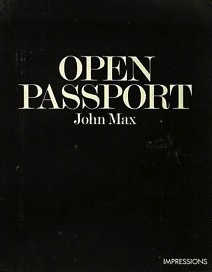 Max’s images are fairly exclusively concerned with people; the “open passport” of the title would appear to offer access to other beings rather than to geographical territory. He sees them with a peculiar, almost jarring combination of ferocity and tenderness, revealing both the skull beneath the skin and an almost child-like vulnerability. These are not stolen moments by any means, despite the format. Almost all are close-ups, and many are transactional portraits; these seem to be people Max knows, and knows well. This is a very strong body of work, one whose integrity compensates (though that is surely not its intent) for the frequent abuse of the snapshot mode. (See “The Photography Book as Autobiography,” New York Times, August 11, 1974, p. D25.)
Max’s images are fairly exclusively concerned with people; the “open passport” of the title would appear to offer access to other beings rather than to geographical territory. He sees them with a peculiar, almost jarring combination of ferocity and tenderness, revealing both the skull beneath the skin and an almost child-like vulnerability. These are not stolen moments by any means, despite the format. Almost all are close-ups, and many are transactional portraits; these seem to be people Max knows, and knows well. This is a very strong body of work, one whose integrity compensates (though that is surely not its intent) for the frequent abuse of the snapshot mode. (See “The Photography Book as Autobiography,” New York Times, August 11, 1974, p. D25.)
You Don’t Know Me from The Wind
Perusing it after a considerable interval reminded me that, thirty years after I wrote it, this passage about John Max’s book would undergo a bizarre misreading by the Canadian scholar Penny Cousineau-Levine. To wit:
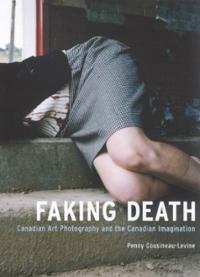 “In a 1974 New York Times review of John Max’s book of photographs, Open Passport, photography critic A. D. Coleman, while praising the book’s photographs for their distinctive vision, takes Max to task for his ‘frequent abuse of the snapshot mode.’ In the same year, reviewing the National Film Board’s publication of Judith Eglington’s Earth Visions in Afterimage, I wrote that if the photographer had sought to underline the beauty of the natural landscape she might have done better to use a large format camera.
“In a 1974 New York Times review of John Max’s book of photographs, Open Passport, photography critic A. D. Coleman, while praising the book’s photographs for their distinctive vision, takes Max to task for his ‘frequent abuse of the snapshot mode.’ In the same year, reviewing the National Film Board’s publication of Judith Eglington’s Earth Visions in Afterimage, I wrote that if the photographer had sought to underline the beauty of the natural landscape she might have done better to use a large format camera.
“These two statements share a misunderstanding of Canadian photography. Both betray the reviewer’s presumption that there is no reason not to apply established critical precepts like the ‘snapshot’ aesthetic and the ‘appropriate’ use of a view camera to the work under consideration just because that work happened to have been made by a Canadian photographer. And on one level this attitude may have been correct, if one assumes that criticism is about applying a standardized (which is to say, ‘international’) system of evaluation that ascertains how a given product ‘measures up’ to abstract, idealized, and currently fashionable notions of what constitutes an acceptable work of art….
“The problem is, of course, that this monolithic approach almost guarantees that enormous chunks of the work under consideration will slip through the critical cracks, that whatever exists in the work that cannot be mediated through the ‘universal’ terms of discourse the critic employs risks being missed altogether. And if not much in the work does lend itself to being discussed in these critical terms, the work may be barely seen at all, with the conclusion that nothing exists in the work to be seen.” (See Cousineau-Levine, Penny, Faking Death: Canadian Art Photography and the Canadian Imagination, Montreal, Canada: McGill-Queen’s University Press, 2003, pp. 15-16.)
That Don’t Make It Junk
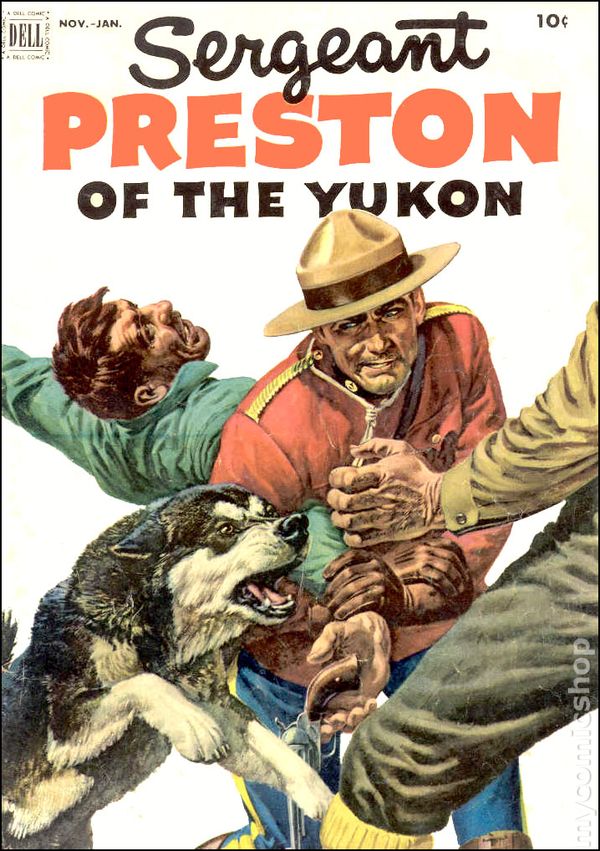
“Sergeant Preston of the Yukon” #5 (Nov. 1952-Jan. 1953), Dell Comics, cover
Quite a burden for a little 200-word book review from 1974 to bear. And nothing in the above bill of particulars resembles in the slightest either that review or any beliefs or practices of mine, now or in the past.
Yet surely insidious, hegemonic U.S. cultural imperialism (e.g., Sergeant Preston of the Yukon, Dudley Do-Right) has done grievous, perhaps irreparable harm to Canadian culture, far outweighing the damage that agents of Canadian cultural imperialism like Drake, Leonard Cohen, Robbie Robertson, Rick Danko, Richard Manuel, Garth Hudson, Oscar Peterson, Gil Evans, Maynard Ferguson, John Candy, Jim Carrey, Robertson Davies, Alice Munro, Michael Ondaatje, Stephen Leacock, Marshall McLuhan, Douglas Coupland, Lorne Michaels, Norman Jewison, Pamela Anderson, David Cronenberg, Margot Kidder, Donald and Kiefer Sutherland, William Shatner, Rae Dawn Chong, and Ryan Gosling have done to us in turn. Doubtless we owe some reparations, payable even by those who did not perpetrate the injustices. So, as Allen Ginsberg once said, “America, I’m putting my queer shoulder to the wheel.”
Still, I’ve personally done none of the things of which Cousineau-Levine has accused me, and she knows it. Which makes me just a target of opportunity. Though I’ll tolerate the flogging, I do feel the need to set the record straight.
Sorry, Baby, Doesn’t Look Like Me At All
Far from being an “established critical precept” in 1974, the term “snapshot aesthetic” was at that point newly minted and the subject of considerable debate in photography’s still-small circles. Furthermore, that comment about the “frequent abuse of the snapshot mode” did not refer to Max’s work, which I’m differentiating from assorted failures presented with that rubric as their validation. (Note, please, that I referred to the “snapshot mode,” not the “‘snapshot’ aesthetic.” Note also the precision of the locution: I wrote “the frequent abuse of the snapshot mode,” not “his” ― Max’s ― or “its” ― his work’s ― abuse thereof.)
The reference here, which my regular readers back then would have found clear, was to previous, then-recent New York Times and Village Voice columns of mine in which I had discussed vernacular photography and various usages by contemporary photographers of what was becoming known as the “snapshot aesthetic,” whose premises I’d questioned and some examples of which I’d evaluated as superficial and self-indulgent. Hence I wasn’t “taking Max to task” in any way, but instead praising his work as a corrective or counterbalance to that of others.
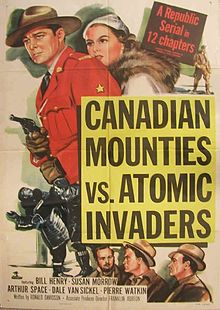
“Canadian Mounties vs. Atomic Invaders” (1953), movie poster
So, chancing upon Cousineau-Levine’s volume at a book party in Montreal when it came out, I was amused to open it back in my hotel room only to find it had as its jumping-off point this extreme misinterpretation of my work by a Canadian ― a grammatical misreading that serves as the partial foundation for her entire book-length argument, converting something intended as a U.S. critic’s respectful acknowledgment of Max’s achievement into a slight (even if unintended) directed against Canadian photography and Canadian culture.
This elementary error invalidates the author’s claim that I “share a misunderstanding of Canadian photography.” Thus, in her opening paragraphs, Cousineau-Levine undermines her own subsequent argument and impeaches her own scholarship.
Hey, That’s No Way to Say Goodbye
The decontextualization and misrepresentation of my comments about Max serves a purpose. It provides Cousineau-Levine with the necessary example of a high-profile non-Canadian (c’est moi) in a high-profile non-Canadian publication (the Times) purportedly misunderstanding Canadian photography as a consequence of “assum[ing] that criticism is about applying a standardized (which is to say, ‘international’) system of evaluation that ascertains how a given product ‘measures up’ to abstract, idealized, and currently fashionable notions of what constitutes an acceptable work of art.”
Branded thereby as someone imposing “‘universal’ terms of discourse” on all and sundry, I become the straw man standing in for all those from elsewhere who somehow don’t get Canada — another cultural imperialist from the States, however well-meaning.
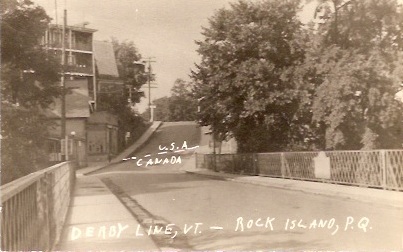
U.S.-Canadian border, looking south from Rock Island, Quebec. Anonymous photo postcard, n.d. Collection A. D. Coleman.
To take some of the sting out of this accusation, Cousineau-Levine follows it immediately with her own confession to committing the same sin of subscribing to a “monolithic approach” to the critical act. I don’t know if she deserves her self-castigation, but, having recently re-read not just the Max review but all my 121 columns for the Times, I can say with confidence that what I actually wrote during that period, including that review, does not in any way support the attitudes and methods she projects onto me. …
•
This post supported by a donation from photographer Peter Kayafas.






Cousineau-Levine’s mal-quotation is cringeworthy.
We Canadians are often guilty of lazy thought when talking/writing about the US. Cousineau-Levine is using — and inexcusably for a scholar — the same tired “monolith” trope (or rather, the “sleeping-next-to-an-elephant” trope). I sometimes think we Canucks need to watch fewer minutes of partisan US cable TV and more minutes of Bill Moyers if only to hear and appreciate the breadth and depth of intelligent political discourse in the US, let alone discourse in the US arts scene.
Cousineau-Levine’s bit about “Canadian photography” is also a bit surprising given how different the Vancouver school is from Burtynsky which differs from Arnaud Maugs, etc. etc. In my opinion there is no such thing as single “Canadian photography” unless you live in Central Canada and think that there is no culture west of Thunder Bay, Ontario. However, that’s perhaps me adding more heat than light to a long-running family squabble, and honesty demands I first read her book before making too big a fool of myself.
The “snapshot aesthetic” bit resonates with me for an additional reason. The following is from your review of an early 1970s show of Fundi’s work and reprinted in “Light Readings” (p. 63).
Whether or not the “snapshot” or “street photography” aesthetic is used, the resulting work can still be without life, energy, substance or truth. My sense is that you were aiming at those latter concerns — i.e., their actual presence in John Max’s work — within your excerpt from the “Open Passport” review, and that theorists (?) such at Cousineau-Levine seem to have a different aim (to which I might not be entirely sympathetic).
I’m looking forward to the arrival of your two-volume set!
Good to have a Canadian take on this. Thanks for making the time to formulate a considered response.
That’s the entirety of my commentary on Max’s book, part of a cluster of book reviews that made up that week’s Times column. In the phrase that Cousineau-Levine extracted and misrepresented I did indeed try to indicate that Max had actually accomplished something to which numerous others only pretended.
There’s definitely an overlap between “street photography” and the “snapshot aesthetic,” both of them connected to John Szarkowski’s book and show The Photographer’s Eye and his subsequent three-person exhibition “New Documents” with Arbus, Friedlander, and Winogrand. Much more than I could unpack in these responses to Cousineau-Levine’s project, and not really necessary for the points I’m making, at least not for readers like yourself who share these reference points. (For those who don’t, as Casey Stengel often said, “You could look it up.”)
More to come.
The anonymous publisher/author of the blog Korean Photography Books (now there’s a niche for you) offers a thoughtful take on this post. Neither Korean nor a speaker of Korean, he or she is responding cross-culturally to the given subject. John Berger and I are cited as primary models; I blush to note that the post opens, “A.D. Coleman’s observations on photography are always acutely astute,” calling Photocritic International a “must read.”
On closer scrutiny, this blog bears a copyright notice from photographer Michael N. Meyer. It’s buried at the very bottom of the right-hand toolbar, hence my overlooking of it.
Your post was a fascinating read. I might take the other author (Cousineau-Levine) more seriously If I could find more of her work. Alas, it seems like she has only published this book, despite a thirty year academic career.
Thanks for this. I hope you got to read the whole three-part series. (There are links to the other parts at the bottom of each post.)
I don’t know much about Cousineau-Levine myself, save that, in her unhyphenated phase as Peggy Cousineau back in the 1970s, she exhibited photographic work that I saw reproduced in several Canadian catalogs and magazines.
In a Google search of her name (Peggy Cousineau-Levine) these three posts appear as the first results, suggesting a minimal online and public presence.